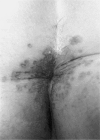Sexually transmitted proctitides
- PMID: 20011362
- PMCID: PMC2780151
- DOI: 10.1055/s-2007-970201
Sexually transmitted proctitides
Abstract
Patients with sexually transmitted proctitides are increasingly presenting to doctors' offices. This may be secondary to increasing numbers of individuals participating in anal receptive intercourse and a rise in the incidence of sexually transmitted diseases. Although the sexually transmitted proctitides represent a small proportion of the overall number of cases of new proctitis, in certain populations the incidence of these diseases as causative agents is quite high, especially among men who have sex with men. Common causative agents include Neisseria gonorrhoeae, Chlamydia trachomatis, Treponema pallidum, and herpes simplex. Diagnosis may often be made on clinical grounds alone, and treatment requires antibiotics or antivirals. The clinician must remember to keep these diseases in mind while formulating a differential for the cause of proctitis.
Keywords: Sexually transmitted proctitis; anal receptive intercourse; proctitides.
Figures




Similar articles
-
Sexually transmitted diseases syndromic approach: proctitis.G Ital Dermatol Venereol. 2012 Aug;147(4):395-406. G Ital Dermatol Venereol. 2012. PMID: 23007214
-
2021 European Guideline on the management of proctitis, proctocolitis and enteritis caused by sexually transmissible pathogens.J Eur Acad Dermatol Venereol. 2021 Jul;35(7):1434-1443. doi: 10.1111/jdv.17269. Epub 2021 May 31. J Eur Acad Dermatol Venereol. 2021. PMID: 34057249
-
2013 European Guideline on the management of proctitis, proctocolitis and enteritis caused by sexually transmissible pathogens.Int J STD AIDS. 2014 Jun;25(7):465-74. doi: 10.1177/0956462413516100. Epub 2013 Dec 18. Int J STD AIDS. 2014. PMID: 24352129
-
Proctitis: a glance beyond inflammatory bowel diseases.Minerva Gastroenterol Dietol. 2020 Sep;66(3):252-266. doi: 10.23736/S1121-421X.20.02670-7. Epub 2020 Mar 24. Minerva Gastroenterol Dietol. 2020. PMID: 32218425 Review.
-
Sexually transmitted proctitis.Clin Colon Rectal Surg. 2015 Jun;28(2):70-8. doi: 10.1055/s-0035-1547334. Clin Colon Rectal Surg. 2015. PMID: 26034402 Free PMC article. Review.
Cited by
-
Testing for Drug-Related Infectious Diseases and Determinants among People Who Use Drugs in a Low-Resource Setting: A Respondent-Driven Cross-Sectional Survey.Trop Med Infect Dis. 2022 Aug 29;7(9):213. doi: 10.3390/tropicalmed7090213. Trop Med Infect Dis. 2022. PMID: 36136624 Free PMC article.
-
Lymphogranuloma Venereum-Associated Proctitis Mimicking a Malignant Rectal Neoplasia: Searching for Diagnosis.GE Port J Gastroenterol. 2021 May 6;29(4):267-272. doi: 10.1159/000516011. eCollection 2022 Jul. GE Port J Gastroenterol. 2021. PMID: 35979244 Free PMC article.
-
Improving gonorrhoea molecular diagnostics: Genome mining-based identification of identical multi-repeat sequences (IMRS) in Neisseria gonorrhoeae.Heliyon. 2024 Mar 5;10(6):e27344. doi: 10.1016/j.heliyon.2024.e27344. eCollection 2024 Mar 30. Heliyon. 2024. PMID: 38533083 Free PMC article.
-
Provincial distribution and factors associated with self-reported sexually transmitted infections and their symptoms among women in Sierra Leone.BMC Infect Dis. 2024 Nov 8;24(1):1265. doi: 10.1186/s12879-024-10030-x. BMC Infect Dis. 2024. PMID: 39516716 Free PMC article.
-
Individual and community level factors associated with sexually transmitted infections among men in Tanzania: insights from the Tanzania demographic and health survey of 2022.BMC Infect Dis. 2024 Jun 12;24(1):580. doi: 10.1186/s12879-024-09470-2. BMC Infect Dis. 2024. PMID: 38867176 Free PMC article.
References
-
- Valleroy L A, MacKellar D A, Karon J M, et al. HIV prevalence and associated risks in young men who have sex with men. Young Men's Study Survey Group. JAMA. 2000;284:198–204. - PubMed
-
- Fenton K A, Imrie J. Increasing rates of sexually transmitted diseases in homosexual men in Western Europe and the United States: why? Infect Dis Clin North Am. 2005;19:311–331. - PubMed
-
- Cohen J, Powderly W G. Infectious Diseases. 2nd ed. St. Louis: Mosby; 2004.
-
- Modesto V L, Gottesman L. Sexually transmitted diseases and anal manifestations of AIDS. Surg Clin North Am. 1994;74:1433–1464. - PubMed
-
- Sexually transmitted diseases treatment guidelines 2002. MMWR Recomm Rep. 2002;51(RR-6):1–78. - PubMed

